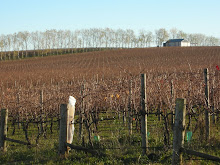Wine industry innovation: international exchanges in the wine sector
In Decanter’s September issue, Margaret Rand takes a look at the kind of exchanges that take place between the new world and old world of the wine industry.
I had a discussion with someone today, the nature of which made me question whether this constant dichotomy between new and old is helpful, but as it still exists and the wine industry is likely to continue down this split line, I’ll probably continue looking at things in this way, too.
The Decanter article was good because I think it highlights the point that I made in my last post – that Australia has a reputation for innovation in the wine industry. This is excellent for the Australian wine industry which, as I have said before, too often limits itself to a definition of quality for money (rather than just quality full stop).
The innovation goes beyond the use of screw caps and eye catching marketable labels. An interesting example came from Spain’s port-marking region and David Guimaraens, who went from Fonseca Port to Roseworthy Agricultural College to gain the empirical knowledge required to modernise the port making practices in his family business.
Another example, so pertinent in times where climate change is on everyone’s lips, was that of Philippe Guigal from the Rhone region in France, who was streaks ahead of his other wine maker counterparts during an extremely hot vintage. Harvest and racking and fermentation techniques to reduce the impact of a hot vintage were learned during his time in Australia and California.
But what about Australians travelling ‘back’ to the old world for an insight into how things are done in Europe..? The examples given here is exactly what is needed in these parts to show Europeans that Australian wine can compete with the best of them. The examples are what I needed in recent debates with a colleague over the use of chemicals and the lack of a ‘cru’ system in Australia (I will examine this topic at a later date because it was a particularly fascinating discussion we had).
Yalumba has perhaps pioneered the use and diffusion of the Viognier grape among Australian wine, and it learned this through a trip that Louisa Rose undertook to the Rhone. While she says that things weren’t that different in the Rhone, at least she was reassured that Yalumba was moving in the right direction.
The example I loved most was that of Vanya Cullen from Cullen Wines in the Margaret River, who is now employing bio-dynamic production in her vineyards. I am really impressed with the direction bio-dynamic wine making is taking, and the coverage it’s getting. Apparently it is one of the best ways to express terroir and I think Australia needs to get back in touch with its roots – that is to say that anything that increases the terroir expression of Australian wines, is a positive thing. The one thing that Cullen points out, that should be noted by anyone from Europe who thinks the new world lacks heritage and terroir, is that Australian soil is older than that in Europe. Bio-dynamics for Cullen, is all about risk taking for future sustainability. Climate change is again a key factor here.
While Decanter did the leg work on the article and provided some nice profiles, it didn’t really have a conclusive argument to make about the benefits to be had from these kinds of exchanges. I would hazard that they could prove to change the wine industry, both old and new, unfathomably.
Labels: australian wine industry, guigal, margaret river, port, rhone, wine industry innovation, yalumba


0 Comments:
Post a Comment
Subscribe to Post Comments [Atom]
<< Home